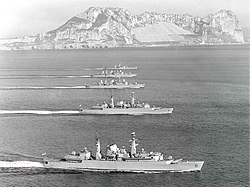Pax Nelbania: Difference between revisions
No edit summary |
|||
| Line 4: | Line 4: | ||
==Nelborne War and Treaty of Reykjavik== | ==Nelborne War and Treaty of Reykjavik== | ||
==1981 Crisis and Treaty of Joghen== | ==1981 Crisis and Treaty of Joghen== | ||
{{see also|1981 Alquiyan-Seketese crisis|Treaty of Joghen}} | |||
[[File:HeadingSouth.jpg|250px|thumb|left|[[Alquiyan Navy|Alquiyan ships]] in the [[Treb Bay]]]] | |||
The Treaty of Reykjavik, following the Nelborne War, established de facto recognition of the Alquiyan-Seketese border. However, tensions persisted due to disagreements over the status of Trjebians and the Rynedan peninsula, as Alquiya claimed it as part of their territory. In September 1981, remarks by Alquiya's Minister of Defense caused concern, leading to the formation of crisis committees by both sides. Military mobilizations occurred, and a four-day stand-off ensued until the Council of Europe and the United Nations brokered an agreement for the withdrawal of forces and a future summit. Both sides complied and withdrew their militaries under UN supervision. | |||
The treaty arising from this summit in Joghen consisted of three main components: recognizing territorial integrity, ensuring peace, and establishing the Nelbec Council. The treaty expressly disallowed war between Alquiya and Seketan, unless authorized by the Council of Europe. The Treaty of Vlyade, signed in 1982, expanded these principles to the entire Nelbec region. | |||
==Nelbec Council== | ==Nelbec Council== | ||
==Nelborne Union== | ==Nelborne Union== | ||
==Critisim== | ==Critisim== | ||
Latest revision as of 15:43, 21 June 2023
Part of a series on the |
|---|
| History of the Nelborne |
Pax Nelbania or Nelborne Peace is a political philosophy and series of treaties with the goal of resolving territorial disputes and creating lasting peace in the Nelborne.
Background
Nelborne War and Treaty of Reykjavik
1981 Crisis and Treaty of Joghen
The Treaty of Reykjavik, following the Nelborne War, established de facto recognition of the Alquiyan-Seketese border. However, tensions persisted due to disagreements over the status of Trjebians and the Rynedan peninsula, as Alquiya claimed it as part of their territory. In September 1981, remarks by Alquiya's Minister of Defense caused concern, leading to the formation of crisis committees by both sides. Military mobilizations occurred, and a four-day stand-off ensued until the Council of Europe and the United Nations brokered an agreement for the withdrawal of forces and a future summit. Both sides complied and withdrew their militaries under UN supervision.
The treaty arising from this summit in Joghen consisted of three main components: recognizing territorial integrity, ensuring peace, and establishing the Nelbec Council. The treaty expressly disallowed war between Alquiya and Seketan, unless authorized by the Council of Europe. The Treaty of Vlyade, signed in 1982, expanded these principles to the entire Nelbec region.
